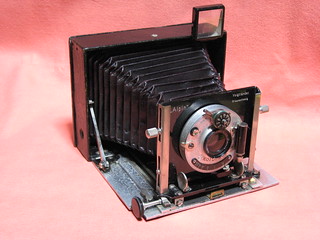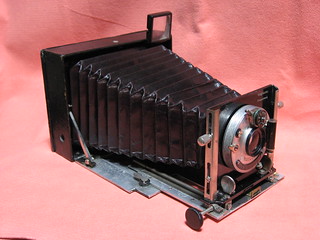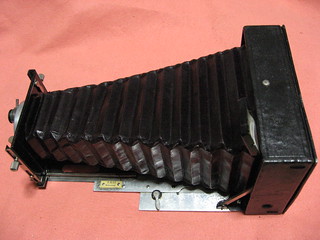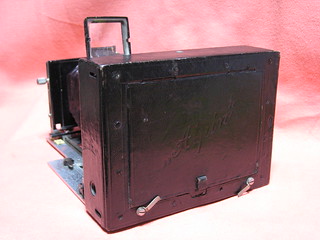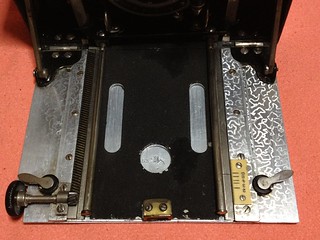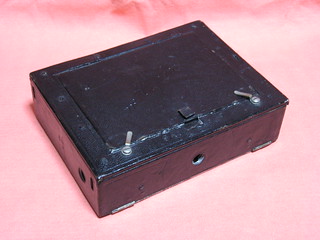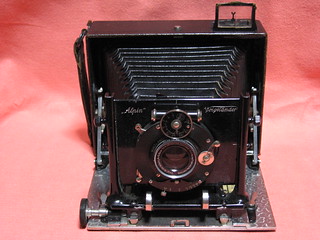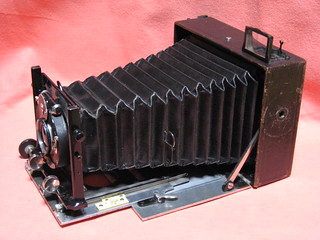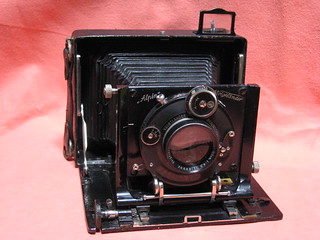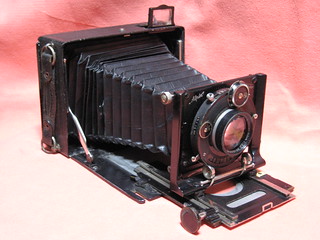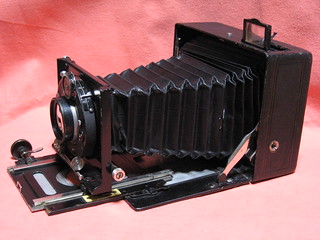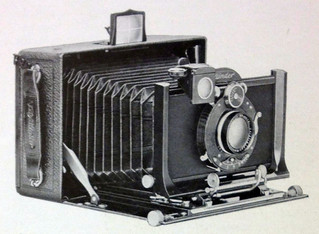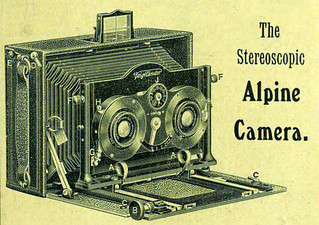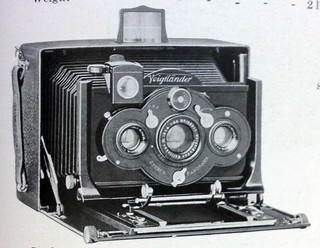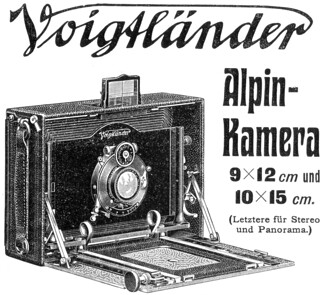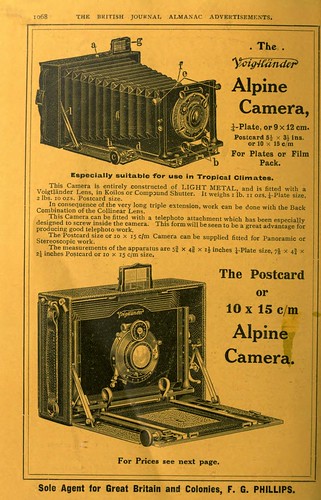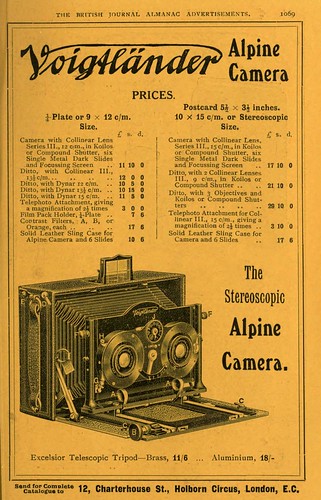User:Heritagefutures/WorkSpace3
|
The Alpin[1] are horizontal folding bed plate cameras made by Voigtländer (Braunschweig/Germany) from 1907 to 1928.[2]
Conceptually, the Alpin is a further development of the Metall-Heliar-Kamera, a 180mm horizontal folding bed plate camera with a cast aluminium body and fitted with a focal plane shutter (introduced in 1903 and built until 1920).[3]
Common to all Alpin cameras is a cast aluminium body with a heavy folding bed,double and later triple extension bellows, and a single focussing wheel at the photographer's right.[4] A Teletubus with 2½× magnification could be mounted inside the unfolded camera. Tourists liked the camera because it was quite compact when folded; provided a horizontal format suitable for landscapes and group photographs; and it was made of light metal. It was produced in two plate sizes (9x12 and 10x15, the latter for panorama and stereo imagery) and offered in a wide variety of lens combinations. The Alpin is not to be confused with the horizontal version of the Voigtländer Avus 9x12 which only had a standard bellows.[5]
The design of the Voigtländer Alpin influenced other camera manufacturers to create similar cameras. A close copy of the second version is Rokuoh Sha's' horizontal Lily which was offered from 1916 to 1930. Similar developments by other German manufacturers were the Bentzin Rechteck Primar (10 x 15 stereo, ~1912), the Ernemann Heag XII Modell III (9x12, 10 x15 and stereo, ~1912), the Rietzschel Heli Clack (10x15, Stereo, 1913), the Ica Toska (9x12 and 10 x 15 panorama & stereo, 1914), the Ihagee Venus (9x12, 1916), the Orion Rio 44C (9x12, 1921), the Perka Silar (9x12 and 10x15, 1922); the Rietzschel and later Agfa Ninon ( 9x12, 1925), the Ica and later Zeiss-Ikon Universal Juwel (model 275/7 9X12, 1927), and the Laack ¶¶ (9x12 and stereo).
see also this so far unidentified French horizontal folding bed camera (mine):
possibly a German-made aluminium body (but note the focussing wheel INSIDE the front plate (like on the Metall-Heliar-Kamera (which has TWO wheels)
has French-supplied Berthiot Special 105mm f/4.5 (sn # 502651) in Gitzo 2R shutter (1950s?)
http://www.flickr.com/photos/heritagefutures/5464782666/
9x12 format
The rectangular front standard of the camera has a flat upper and lower margin and allows for rise and fall as well as lateral movements.
The camera has two tripod sockets, one on the base and one on the left hand side of the camera.
Find these refs: (in the National Library under S 770.5 BRI off-site storage) British Journal Photographic Almanac 1906, p. 1370B; British Journal Photographic Almanac 1907, pp. 904, 1347; British Journal Photographic Almanac 1909, p. 1119; British Journal Photographic Almanac 1912, p. 1076; British Journal Photographic Almanac 1913, pp. 740, 1098; British Journal Photographic Almanac 1925, p. 746.
Müller, Klaus-D. (XXXX) Voigtländer & Sohn Optische Anstalt Braunschweig. Objektive und Apparate 1840 - 1939. Photographica Bibliothek vol. 3, p. 186, 187, 249 The Camera vol. 18, p. 753
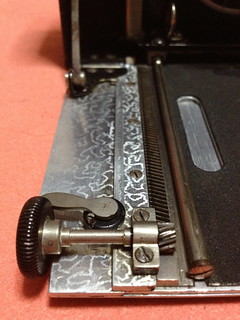
|
| The patterned baseboard typical of all Alpin models also visible is the focussing wheel and the brake for the second extension (shown is an Alpin version 1) image by Kazutaka Tsutsui (Image rights) |
Version 1, 1905-07
start date 1905 or 1906?
This model has a pop-up Newton finder at the top left, which, when folded down, is fully inside the casing.[6] The finder frame is quadrangular with a thin cross-hair etched in.
The folding bed of the camera shows exposed aluminium that has been ornamented with an irregular squiggly pattern applied by a dremel. As the pattern is applied by hand, no camera bed is exactly the same in appearance. The unpainted metal face of the Koilos shutter shows a similar irregular pattern.
The first version introduced in 1905 carried the name of the camera between (German-style) quotation marks („Alpin”) at the top left of the front standard, and the name and place of the manufacturer at the top right as a two-line inscription (Voigtländer, | Braunschweig).
From the start Voigtländer offered two versions of the camera, the Standard model which was covered with black Morocco leather, and a Tropical model (the 'Metall-Alpin-Kamera'), where the outside of the metal housing was textured and covered with black bake enamelled paint.[7]
Sales [8]
The 1907 Katalog has an Alpin on the Cover —Voigtländer Objektive und Apparate für Photographie 1907.
„Alpin” normal script and Voigtländer | Braunschweig normal script Collinear III f/6.8 12cm (sn 83546) in Koilos lens date:1906 Kazutaka Tsutsui on Flickr; see also Alpin Collinear III f/6.8 12cm in Koilos Breker March 2006, Lot 122 Collinear III f/6.3 12cm in Compound camerascollection.blogspot Voigtländer Cooke Linse (sn 90101) in Koilos lens date:1907 Breker April 2005 Lot 231 (red bellows)

|
| Collinear III, 12cm f/6.8 in Koilos shutter image by Kazutaka Tsutsui (Image rights) |
Lens options
The first version of the Alpin was offered with three focal lengths, 120mm, 135mm and 150mm, all set in either Bausch & Lomb Automat, Compound or Koilos shutters:[9]
120mm
135mm
150mm
- Dynar f/5.5 150mm
- Triple Anastigmat f/7 150mm
Teleansatz 97 mm c.1908 Lens Type: Telephoto attachment. Fixed separation. For 15 cm primary lens. 2.5x Magnification. For 10 x 15 cm. Serial Number: 103244 . With: Box. This is a conventional telephoto attachment consisting of a negative lens for mounting behind a normal objective. The attachment is for use with hand cameras such as the Voigtländer Alpin. It fits inside the bellows and screws to the rear of the lens panel. It was made in two sizes for quarter-plate (12 or 13.5 cm objectives) and 5 ½" x 3 ½" (15 cm objectives). References & Notes: BJA 1909, pp. 722, 1119.; BJA 1912, pp. 1077, 1086. http://www.earlyphotography.co.uk/site/entry_L72.html
|
|
| ||||||
|
|
| ||||||
|
Voigtländer Alpin 9 x 12cm (version 1) with Collinear III, 12cm f/6.8 | ||||||||
Version 2, 1908-28
The new Alpin was first advertised in the German press in 1909
The camera has a fold-up Newton finder at the top left, which, when folded down, remains external, but is flush with the casing. The top of the finder frame has an apex, while the glass has red cross-hairs etched in. A folding Brillant-type finder which attached to the front standard could be purchased as an extra option.[14] The leather hand strap, with an embossed 'Voigtländer' name tag, is at the right hand side of the body, while tripod sockets are locate the the bottom and the centre of the left side of the body . The fold-out cover for the focussing screen is embossed „Alpin”. The catch for the front door is released by pressing a button on the top plate.[15] The Alpin was a triple extension camera operated by a spiral rack and pinion with a lock. A large focussing wheel is at the right fore edge of the fold-down front door. This model was produced until 1928.[16]
Sales History
Based on available catalogues and advertisements in journals and newspapers, the Alpin was formally distributed in Germany,[17] Austria, Switzerland,[18] the United Kingdom,[19] the USA,[20], Austria and France.The distribution structure is not fully clear, but it would appear that from 1911 to about 1926 Voigtländer handled its own distribution of the Alpin rather than relying on major local distributors. Indeed, the situation in France was such that Voigtländer was apparently not stocked by the main French camera houses until 1927/28 [21]. Thus there are no listings for the Alpin in the catalogues of any of the major Paris retailers such as Omnium-Photo, Photo-Hall, Photo-Plait, Photo-Sport or Tiranty. The only French listings of the Alpin that could be found occurred pre World War I, contained in the catalogue of the mail order house Manufacture Français d'Armes et Cycles de Saint-Ètienne.[22]
Types
Three types have been observed which show a number of technical as well as cosmetic differences. They can be best distinguished by the lettering variations of the front standard:[23]
Type A: normal script: „Alpin” at left and Voigtländer (with 'Braunschweig' below) at right (1907-1909)
Type B: running script horizontal: „Alpin” at left and Voigtländer (with top swirl from the 'r' ) at right (1906–1910?)
Type C: running script set at 30° inclination:
Variant 1: Voigtländer (with top swirl from the 'r' ) at left and „Alpin” at right (~1907)
Variant 2: „Alpin” at left and Voigtländer (with top swirl from the 'r' ) at right (1910?–1930)
Types A and B seem to occur concurrent, at least in the early part, with the lens serial numbers intermingled. It is quite possible that these lettering types represent cameras marketed for German-speaking countries (type A) and the rest of the world (type B).[24] It can be surmised that the special lettering was dropped in favour of a universal labelling.
Type A (1907-1909)
The lettering of the front board is rendered in normal script: „Alpin” at left and Voigtländer (with 'Braunschweig' below) at right.
„Alpin” normal script and Voigtländer | Braunschweig normal script Collinear III f/6.3 132mm (sn 99071) in Compound lens date:1908 eBay 320965243662 (August 2012) Collinear III f/6.3 132mm (sn 101698) in Compur lens date:1909 eBay 120953995217 (July 2012) Dynar f/6 12cm (sn 88592) in Koilos lens date:1907 Pierre Dalger
Type B (1906-1910)
The lettering of the front board is rendered in running script horizontal: „Alpin” at left and Voigtländer (with top swirl from the 'r' ) at right.
Changes between A and B
edges of front standard have a different shape
finger grips on sled
position of wheel for arresting vertical movement of front standard
position of tripod socket on left side
In addition, the sides of the bellows of Type B units have a small metal loop on on of the folds to prevent the bellows from sagging when the second and third extension are not fully extended.[25]
„Alpin” running script horizontal, and Voigtländer running script horizontal Collinear IIInº2 f/6.8 4¾inch (sn 84424) in Koilos lens date:1906 eBay 200800224776 (August 2012) with US Patent nº Collinear III f/6.8 12cm (sn 101422) in Koilos lens date:1908 eBay 350485857317 (September 2011) Collinear III f/6.8 4¾inch (sn 105058) in Compound lens date:1909 Kazutaka Tsutsui via Flickr Collinear III f/6.8 132mm (sn 98496) in Compound lens date:1908 Photo Rahn Photographica Auction 5 Lot 424 Collinear III f/6.8 132mm (sn 103198) in Compound lens date:1909 W Boisen via Flickr Dynar f/5.5 12cm (sn 84815) in B&L Automat lens date:1906 http://www.earlyphotography.co.uk/site/entry_C301.html
|
|
| ||||||
|
Voigtländer Alpin 9 x 12cm (version 2 script type B) with Collinear III, 4¾ inch f/6.8 | ||||||||
Type C (~1907; 1910-1930)
The principal changes introduced with type C are that the focussing wheel has been moved inwards from the right fore edge of the folding bed and now runs in a slot, some 5mm from the edge. We can presume that this design modification was introduced to prevent accidental focus adjustment. The front standard has been redesigned, with a ¶¶ shape and with ¶¶ edges. The screw for arresting the vertical movement of the front board is now placed at the very top of the U-shaped fork rather than 1/4 down as in the previous model. The ginger grips for the sled have been enlarged and placed on a spring-loaded fold-down unit, which allows for an easier grip, especially for larger hands.
Overall, the edges of the casing of metal body are now rounded rather than crisp as in the previous models.
changes between B and C/D: Struts All variant D after 1913 seem to have a Compur Shutter wheel for arresting vertical movement of front standard on top, rather than 1/4 down as on B sled brake on left has disappeared in C&D
Variant 1
The lettering of the front board is rendered in running script set at 30° inclination:Voigtländer (with top swirl from the 'r') running script 30° inclination at left and „Alpin” running script 30° inclination at right. One example has been observed fitted with a Collinear III f/6.8 132mm in a Compound shutter. The serial number of that lens suggests a manufacture of 1907, which would make it contemporary with Types A and B.[26]
Observed lenses Variant 1
running script 30° inclination, ad Voigtländer with top swirl from the 'r' at left and „Alpin” at right
Collinear III f/6.8 132mm (sn 96492) in Compound lens date: 1907 http://www.kasafo.de/images/kameras/platten/alpin/alpin1800.jpg
Variant 2
The lettering of the front board is rendered in running script set at 30° inclination: „Alpin” at left and Voigtländer (with top swirl from the 'r' ) at right. This became the uniform pattern of lettering from about 1911 onwards.
Observed lenses Variant 2 running script 30° inclination, „Alpin” at left and Voigtländer with top swirl from the 'r' at right Heliar f/4.5 13.5cm (sn 169120) in Compur lens date: 1921 http://www.cinci.de/einzel/59.html Heliar f/4.5 13.5cm (sn 176778) in Compur lens date: 1922 ebay Feb 2012 Heliar f/4.5 13.5cm (sn 189992) in Compur lens date: 1922 Kazutaka Tsutsui via Flickr Heliar f/4.5 13.5cm in Compur http://retronom.hu/node/22412 Kollinear II.2 f/5.4 4¾inch (sn 123208) in Compur lens date: 1913 http://cdn.fotocommunity.com/photos/7202012.jpg Kollinear II.2 f/5.4 4¾inch (sn 127131) in Compur lens date: 1914 eBay 350589311980 (August 2012) Collinear III f/6.3 12cm in Compur http://camerascollection.blogspot.com.au/2011/03/voigtlander-alpin.html Collinear III f/6.3 12cm (sn 80028) in Compound www.leicashop.com/bilder/shop_klein/19610_50.jpg
Kollinear III f/6.8 132mm (sn 112086) in Compound lens date: 1911 on enamelled Voigtländer advertising sign Kollinear III f/6.8 132mm (sn 134783) in Compur lens date: 1915 Fotoauktioner Auktion 26, October, 2012, Lot 191 Kollinear III f/6.8 132mm (sn 138148) in Compur lens date: 1916 http://www.cinci.de/einzel/101.html Kollinear III f/6.8 132mm (sn 140305) in Compur lens date: 1917 http://www.cinci.de/einzel/101.html Kollinear III f/6.8 132mm (sn 161564) in Compur lens date: 1921 ebay 180864519313 (April 2012) Collinear III f/6.8 132mm in Compur eBay 270910952019 (February 2012) Voigtar f/6.3 10.5cm [27]
Goerz (Berlin) Dagor 130 mm lens ebay 370341407741 April 2010
|
|
| ||||||
|
Voigtländer Alpin 9 x 12cm (version 2, Variant C) with Heliar 13.5cm f/4.5 | ||||||||
Lens options
The second version of the Alpin was offered in various focal ranges, broadly speaking 120mm, 135mm and 150mm, all set in Compound, Koilos or Compur shutters. On record are the following lens and shutter combinations:
120mm
- Collinear f/6.3 120mm
- Dynar f/5.5 120mm
- in Bausch & Lomb Automat shutter
- Dynar f/6 120mm
- Triple Anastigmat f/7 120mm
4¾inch (120.5 mm)
- Kollinear II.2 f/5.4 4¾inch
132mm
135mm
- Dynar f/5.5 135mm
- Heliar f/4.5 135mm
- Triple Anastigmat f/7 135mm
150mm
- Dynar f/5.5 150mm
- Triple Anastigmat f/7 150mm
Varied
In addition, an Alpin was observed fitted with a Voigtar f/6.3 10.5cm,[36] which is most likely a post-market modification with a lens and shutter unit salvaged from a Bessa.
Version 3, Alpin Rapid (~1925)
The Alpin Rapid was a prototype for a development that was not followed through.[37] A camera with red, single extension bellows. The fold-down front bed has a deep recess to allow for the bulging Skopar in Turbo Shutter. The canera has red spirit-filled bubble levels on top and on left side. An expandable waist-level viewfinder mounted on the top of the camera. Fitted with Anastigmat Skopar f/4.5 13.5cm in Voigtländer Turbo Shutter.
10 x15 format
Soon after the introduction of the 9x12 model, Voigtländer realised that there was a market for a wider format, more suitable for landscapes and group photographs. In consequence, the 10 x 15 version was introduced.[38]
The camera has a fold-up Newton finder in the center, which, when folded down, is external, but flush with the casing. The top of the finder frame has an apex, while the glass shows etched-in red cross-hairs.
no text on front board central section of front standard has a curved higer section. Rotating disc?
10x15 no text on front board Collinear f/6.3 (sn 97983) in Compound lens date: 1907 Christies Sale 7145, March 1996, Lot 337 Collinear f/6.3 16.5cm (sn 132247) in Compur lens date: 1914 http://www.blende-und-zeit.sirutor-und-compur.de/thread.php?board=1&thread=5 Collinear f/12.5 15cm (sn 618505) lens date:~1930 Westlicht nº 4, November 2003, Lot 360
Goerz Doppel Anastigmat 245054 in Compund http://www.kasafo.de/images/kameras/platten/alpinp/alpinp1800.jpg
Version 1, 1908-14
Lens options
The camera was offered in three focal lengths, 165mm, 180mm and 210mm, all set in either Compound or Koilos shutters:[39]
165mm
180mm
- Heliar f/4.5 180mm
210mm
- Heliar f/4.5 210mm
Varied
- Collinear Satzanastigmat with 6 different focal lengths
|
Version 2, 1915-25
The second version of the 10 x 15 Alpin saw the introduction of an additional focussing wheel on the photographer's left.[41]
Version 3, 1926-28
Lens options
The camera was offered as a 'postcard' camera in three focal length, 165mm, 180mm and 210mm, all set in Compound or Compur shutters: 165mm
180mm
210mm
Varied
Stereo Alpin
9 x 12 format Stereo
Mentioned in F Voigtländer Katalog 1907, p. 29
10x15 format Stereo
|
From the start Voigtländer offered two versions of the camera, the Standard model which was covered with black leather, and a Tropical model (the 'Metall-Streo-Kamera'), where the outside of the metal housing was textured and covered with black bake enamelled paint.[49]
Alpin Stereo, two-lens version 1909-1914
The stereo version became available in 1911 and was offered until the end of production in 1928.[50] It came in two versions, the pure stereo with dual lens and shutters[51]
The body of the stereo camera was the same as that of the 10 x 15 format camera, with the exception that the stereo camera had a light-tight partition to allow for two exposures (removable in the case of the three-lens version).
Lens Options
Two Collinear f/6.3 105mm in Stereo Compur shutter for the stereo option.
Alpin Stereo, three-lens version 1909-1914
Voigtländer introduced a new version of the Alpine Stereo, a three-lens version that allowed to take both stereo and, via a centrally placed lens, also panorama images The body of the stereo camera was the same as that of the 10 x 15 format camera, with the exception that the stereo camera had a light-tight partition to allow for two exposures, which was removable for panorama shost.[52]
Lens Options
Two Collinear f/6.3 105mm in Stereo Compound shutter for the stereo option and a centrally located Collinear III f/6.8 150mm for the Panorama option.
|
Alpin Stereo three-lens version 1915–
In 1915 Voigtländer introduced a new three-lens version of the Alpine Stereo, and seems to have abandoned the sales of the pure stereo version.[54]
Lens Options
Two Collinear f/6.3 105mm for the stereo option and a centrally located Collinear III f/6.8 150mm for the Panorama option set in a triple-action Compound shutter.[55]
The 1915 version of the 10 x 15 Alpin saw the introduction of an additional focussing wheel on the photographer's left.[56]
Advertisements
|
|
| ||||||||
| 1908: 9x12 model with Koilos shutter (U.S. Advertisement 1908)(Image rights) |
1911: 10 x15 model with Compound shutter (German Advertisement 1911) (Image rights) |
|
| |||||
|
British Journal Photographic Almanac 1910, p1068-9 | ||||||
Notes and References
- ↑ Spelled 'Alpine' in U.S. advertisements
- ↑ Still listed in Hausamann & Co (1927) Hand- und Preisbuch. St. Gallen (Switzerland): Hausamann & Co. p. 124-125.—No longer included in the 1930 Voigtländer catalogue ('Sein Stolz, eine Voigtländer.' Nr 2308/430. Braunschweig: Voigtländer & Sohn.—See also overview page Alpin at ukcamera.
- ↑ Metall-Heliar-Kamera
- ↑ Later versions of the Alpin 10x15 had dual focussing wheels.
- ↑ Horizontal Avus (1914-1926).
- ↑ Similar design on this unnamed camera with a French lens and shutter combination.
- ↑ The Tropical model was sold with RMk 5 premium: Voigtländer Katalog 1907, p. 29 ¶¶
- ↑ Documented price points in Germany: Collinear III f/6.3 12cm: in Koilos or Compound 1907–RMk 200; Collinear III 135cm: in Koilos or Compound 1907–RMk 210; Triple Anastigmat 12cm: in Koilos or Compound 1907–RMk 170; Sources: 1907— Voigtländer Katalog 1907, p. 29 ¶¶.
- ↑ There are two spellings for the better quality lens used: Collinear and Kollinear. It would appear that the latter is the late 1920s spelling.
- ↑ Voigtländer Katalog 1907, p. 29 ¶¶
- ↑ Voigtländer Katalog 1907, p. 29 ¶¶
- ↑ Voigtländer Katalog 1907, p. 29 ¶¶
- ↑ Seen in a Polish on-line auction July 2009.
- ↑ Catalog of Lenses, Cameras Binoculars and Opera Glasses 1915-1916. Voigtlander & Sohn 240-258 E. Ontario St., Chicado, Ill. and 225 Fifth Avenue, New York, NY, p.38.
- ↑ Unlike many other cameras this button is exposed rather then covered by the leather.
- ↑ No longer included in the 1930 catalogue ('Sein Stolz, eine Voigtländer.' Nr 2308/430. Braunschweig: Voigtländer & Sohn.
- ↑ Documented price points in Germany: Collinear f/6.3 12cm: in Koilos 1912–RMk 230; Dynar f/5.5 135mm: in Koilos 1912–RMk 205; Sources: 1912—Newspaper advertisement (on web, no further bibliographic data).
- ↑ Documented price points in Switzerland: Kollinear III f/6.8 132mm: in Compur 1927–CHF 276 Dynar f/5.5 135mm: in Compur 1927–CHF 264 Heliar f/4.5 135mm: in Compur 1927–CHF 294 Collinear Satzanastigmat with 6 different focal lengths f/7 to f/12.5 1927–CHF 366 Sources: 1927–Hausamann & Co (1927) Hand- und Preisbuch. St. Gallen (Switzerland): Hausamann & Co. p. 124.
- ↑ Documented price points in the United Kingdom: Dynar f/5.5 4¾inch [=12cm] in Compound 1910–£10/5; 1914–£10/5; Dynar f/5.5 5 3/8inch [=13.5cm] in Compound 1910–£10/15; 1914–£10/15; Dynar f/5.5 15cm in Compound 1910–£11/5 Collinear f/6.3 4¾inch [=12cm] in Compound 1910–£11/14; 1914–£11/10; Collinear f/6.3 12cm: in Koilos 1910–£11/14; Collinear f/6.3 5¼inch [=13.5cm] in Compound 1910–£12/4; 1914–£12; .—Sources: 1910–Photographic Cameras, Lenses and Accessories [Catalogue] 1910 Voigtländer & Sohn AG [Printed by Curis & Beanish, Coventry], p. 85; 1910– British Journal Photographic Almanac 1910, p. 1068-69; 1914–British Journal Almanac 1914, p. 1119;
- ↑ Documented price points in the USA: Collinear f/6.3: in Koilos 1908–US$ 60 Collinear II f/5.4 16.5cm in Compur 1915-$74; Collinear III f/6.8 16.5cm in Compur 1915-$70; 19xx—US$ 75 Heliar f/4.5 135mm: in Compur 19xx—US$ 80 Sources: 1908–(Burr McIntosh Monthly (New York), vol. 18 nº 69, December 1908); 1915–Catalog of Lenses, Cameras Binoculars and Opera Glasses 1915-1916. Voigtlander & Sohn 240-258 E. Ontario St., Chicado, Ill. and 225 Fifth Avenue, New York, NY, p.38-39; 19xx–(Advertisement Motion Picture Apparatus Co, New York);
- ↑ The only exception are the irregular listings of the Voigtländer Stereoflektoscop.
- ↑ Price points in France: Collinear f/6.3: in Koilos 1908 & 1909–FFrancs 263; 1910–FFrancs 300 Dynar f/5.5 135mm: in Koilos 1908 & 1909–FFrancs 220; 1910–FFrancs 258 Sources 1908-1910: Catalogue Manufacture Français d'Armes et Cycles de Saint-Ètienne 1908, p. 587; 1909, p. 475; 1910, p. 526.—
- ↑ The dating of the three lettering variants is based primarily on an analysis of the observed serial numbers of the lenses.
- ↑ The rationale for this assumption is that Type A also carries the town name 'Braunschweig' which is the spelling in German-speaking countries (i.e. Germany, Austria and part of Switzerland) while it is spelled 'Brunswick' in both French and English.
- ↑ Presumably, a metal rod would have been slid in there.
- ↑ Until other examples can be documented it cannot be ruled out that this is a later modification.
- ↑ Seen in an on-line auction, Yahoo Japan, October 2012
- ↑ Pierre Dalger
- ↑ Catalog of Lenses, Cameras Binoculars and Opera Glasses 1915-1916. Voigtlander & Sohn 240-258 E. Ontario St., Chicado, Ill. and 225 Fifth Avenue, New York, NY, p.38-39.
- ↑ Catalogue Manufacture Français d'Armes et Cycles de Saint-Ètienne 1908, p. 587; 1909, p. 475; 1910, p. 526 (catalogue page depicted in the catalogue section of the Alpin entry at Sylvain Halgand's site).
- ↑ Catalog of Lenses, Cameras Binoculars and Opera Glasses 1915-1916. Voigtlander & Sohn 240-258 E. Ontario St., Chicado, Ill. and 225 Fifth Avenue, New York, NY, p.38-39.—Hausamann & Co (1927) Hand- und Preisbuch. St. Gallen (Switzerland): Hausamann & Co. p. 124.
- ↑ Catalogue Manufacture Français d'Armes et Cycles de Saint-Ètienne 1908, p. 587; 1909, p. 475; 1910, p. 526 (catalogue page depicted in the catalogue section of the Alpin entry at Sylvain Halgand's site).
- ↑ Hausamann & Co (1927) Hand- und Preisbuch. St. Gallen (Switzerland): Hausamann & Co. p. 124.
- ↑ Hausamann & Co (1927) Hand- und Preisbuch. St. Gallen (Switzerland): Hausamann & Co. p. 124.
- ↑ Hausamann & Co (1927) Hand- und Preisbuch. St. Gallen (Switzerland): Hausamann & Co. p. 124.
- ↑ Seen in an on-line auction, Yahoo Japan, October 2012
- ↑ From the former Voigtländer-Museum in Braunschweig. Breker September 2006, Lot 175; Breker Mach 2009, Lot 127
- ↑ Documented Price Points: UNITED STATES Collinear II f/5.4 16.5cm in Compur 1915-$97; Collinear III f/6.8 16.5cm in Compur 1915-$92; Sources: 1915–Catalog of Lenses, Cameras Binoculars and Opera Glasses 1915-1916. Voigtlander & Sohn 240-258 E. Ontario St., Chicado, Ill. and 225 Fifth Avenue, New York, NY, p.38-39;
- ↑ Documented Price Points: SWITZERLAND: Collinear f/6.3 165mm in Compur 1927: CHF 404; .— Dynar f/5.5 165mm in Compur 1927: CHF 390 .— Heliar f/4.5 165mm in Compur 1927: CHF 442; .— Heliar f/4.5 180mm in Compur 1927: CHF 462; .— Heliar f/4.5 210mm in Compur 1927: CHF 526; .— Collinear Satzanastigmat with 6 different focal lengths, f.6.3 to f/12.5 1927: CHF 492; .—Sources: 1927—Hausamann & Co (1927) Hand- und Preisbuch. St. Gallen (Switzerland): Hausamann & Co. p. 125.— UNITED KINGDOM: Collinear f/5.5 15cm: [=6 inch] in Compound 1910–£17/10; 1914–£15/5; Sources: 1910–Voigtländer Catalogue 1910, p. 88; also: British Journal Photographic Almanac 1910, p. 1069; 1914–British Journal Almanac 1914, p. 1119
- ↑ Catalog of Lenses, Cameras Binoculars and Opera Glasses 1915-1916. Voigtlander & Sohn 240-258 E. Ontario St., Chicado, Ill. and 225 Fifth Avenue, New York, NY, p.39.
- ↑ Illustration in Catalog of Lenses, Cameras Binoculars and Opera Glasses 1915-1916. Voigtlander & Sohn 240-258 E. Ontario St., Chicado, Ill. and 225 Fifth Avenue, New York, NY, p.38.
- ↑ Hausamann & Co (1927) Hand- und Preisbuch. St. Gallen (Switzerland): Hausamann & Co. p. 125.
- ↑ Hausamann & Co (1927) Hand- und Preisbuch. St. Gallen (Switzerland): Hausamann & Co. p. 125.
- ↑ Hausamann & Co (1927) Hand- und Preisbuch. St. Gallen (Switzerland): Hausamann & Co. p. 125.
- ↑ Hausamann & Co (1927) Hand- und Preisbuch. St. Gallen (Switzerland): Hausamann & Co. p. 125.
- ↑ Hausamann & Co (1927) Hand- und Preisbuch. St. Gallen (Switzerland): Hausamann & Co. p. 125.
- ↑ Hausamann & Co (1927) Hand- und Preisbuch. St. Gallen (Switzerland): Hausamann & Co. p. 125.
- ↑ British Journal Photographic Almanac 1910, p. 1069
- ↑ Sold with RMk 5 premium: Voigtländer Katalog 1907, p. 29 ¶¶
- ↑ No longer included in the 1930 catalogue ('Sein Stolz, eine Voigtländer.' Nr 2308/430. Braunschweig: Voigtländer & Sohn.
- ↑ Documented Price Points: UNITED KINGDOM Collinear f/5.5 6inch in Compound 1910–£21/10; 1914–£19/5; Sources: 1910–Voigtländer Catalogue 1910, p. 88; also: British Journal Photographic Almanac 1910, p. 1069; 1914–British Journal Almanac 1914, p. 1119
- ↑ Documented Price Points: UNITED KINGDOM Collinear f/5.5 6inch in Compound 1910–£29/10; 1914–£25/5; Sources: 1910–Voigtländer Catalogue 1910, p. 88; also: British Journal Photographic Almanac 1910, p. 1069; 1914–British Journal Almanac 1914, p. 1119;
- ↑ Catalog of Lenses, Cameras Binoculars and Opera Glasses 1915-1916. Voigtlander & Sohn 240-258 E. Ontario St., Chicado, Ill. and 225 Fifth Avenue, New York, NY, p.39.
- ↑ Documented Price Points: UNITED STATES Collinear f/5.5 6inch in Compur 1915-$165; Sources: 1915–Catalog of Lenses, Cameras Binoculars and Opera Glasses 1915-1916. Voigtlander & Sohn 240-258 E. Ontario St., Chicado, Ill. and 225 Fifth Avenue, New York, NY, p.39.
- ↑ Auktion Team Köln April 2002 Lot 831.— Collinear f/6.3 105mm (sn 112812 & 112813) Collinear III f/6.8 150mm (sn 112814) Westlicht 13, June 2008, Lot 498.—
- ↑ Illustration in Catalog of Lenses, Cameras Binoculars and Opera Glasses 1915-1916. Voigtlander & Sohn 240-258 E. Ontario St., Chicado, Ill. and 225 Fifth Avenue, New York, NY, p.38.

